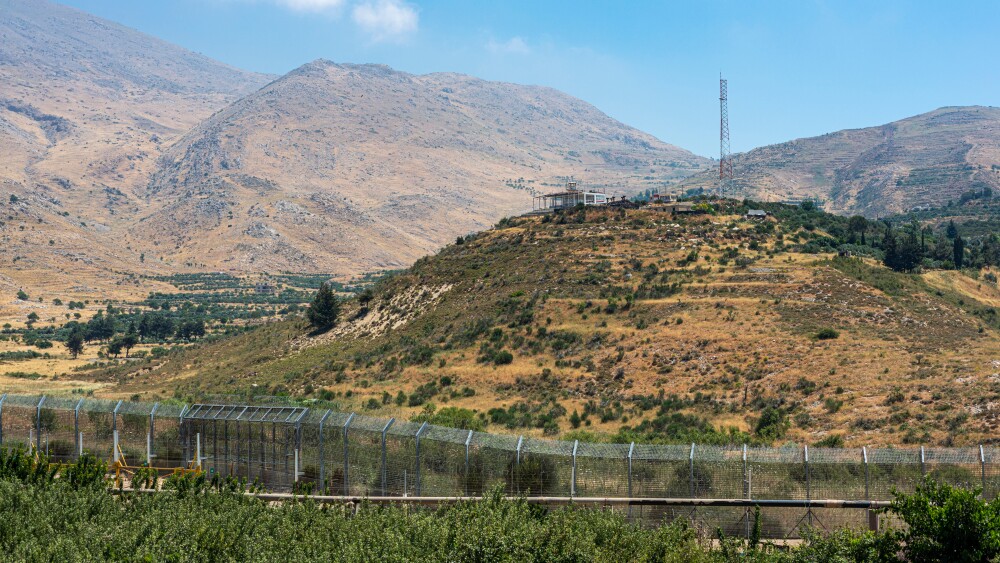In the wake of Syria’s prolonged conflict and the recent reshuffling of regional power dynamics following the October 7 Hamas attacks, Israel has sharpened its focus on the strategically vital Druze communities in southern Syria. As Iran’s foothold in the region weakens and Hezbollah’s influence diminishes amid Syria’s shifting landscape, Israel is recalibrating its approach, offering humanitarian aid and security cooperation to Syrian Druze villages while simultaneously reinforcing its territorial buffer along the Golan Heights. This delicate balancing act underscores Israel’s recognition of the Druze minority not only as a crucial humanitarian concern but as a pivotal regional partner in its evolving security doctrine, signaling a renewed, pragmatic engagement shaped by the complexities of post-Assad Syria and the broader Middle East realignment.
Introduction
Israel’s strategic interest in southern Syria dates to the early 20th century, centered on the Golan Heights and the surrounding Druze communities. This interest reflects a complex blend of humanitarian concerns and security imperatives shaped by evolving regional dynamics and political doctrines. Even before the establishment of the state, Jewish leadership viewed southern Syria not only as a crucial territorial buffer but also as a space for cultivating nuanced relationships with the Druze minority, who often held distinct political and communal identities separate from dominant nationalist movements. This paper explores key historical episodes—including the Allon Plan, early Zionist-Druze diplomatic overtures, and the Yinon Plan—to demonstrate Israel’s multidimensional approach to southern Syria, which balances:
- Maintaining strategic territorial buffers to prevent hostile military threats;
- Engaging minority communities, particularly the Druze, as partners or stabilizers distinct from broader Arab nationalist opposition;
- Shaping regional dynamics to weaken hostile coalitions and preserve Israel’s security and political advantages.
Early Diplomatic Overtures: The Hushi–al-Atrash Meetings (1938–1939)
During the late 1930s, amid the turbulence of the British Mandate and the escalating Arab Revolt, Abba Hushi, a prominent Zionist labor leader, engaged in a series of discreet meetings with Sultan al-Atrash, the iconic Druze leader renowned for leading the 1925 Syrian revolt against French colonial rule. Held between August 1938 and April 1939, these low-profile yet symbolically significant encounters represented one of the earliest efforts by the Jewish leadership to initiate a strategic dialogue with a prominent Arab minority figure. At a time when Arab nationalism was gaining momentum, the talks reflected a bold and pragmatic attempt to explore potential alliances with non-Sunni, non-Arab nationalist actors, specifically the Druze, who had long maintained a distinct communal identity and often found themselves at odds with broader nationalist movements in the region.

Abba Hushi (left) and Sultan al-Atrash (right) during a meeting in Damascus in March 1939. This photograph captures a pivotal moment in early Jewish-Druze relations, reflecting strategic dialogues amid the political complexities of the British Mandate period. Source: Private collection; exact origin unknown.
The discussions included the possibility of Druze communities residing under British rule voluntarily relocating to southern Syria in the event of further regional destabilization. Sultan al-Atrash responded with guarded pragmatism. While he made clear that he did not endorse the Zionist project, he expressed a willingness to accept such relocation if it were pursued voluntarily and aligned with the interests of the Druze themselves. His position underscored a strong commitment to Druze autonomy, neutrality, and self-determination while also highlighting a shared understanding with the Jewish leadership regarding the precarious position of minority groups within the shifting political landscape.
Although no formal agreement emerged from these meetings, they laid important conceptual groundwork for what would later evolve into Israel’s long-term strategy of differentiated engagement with regional minorities. This approach, most notably seen in Israeli policies toward the Druze of the Golan Heights following the 1967 war, sought to distinguish the Druze minority interests from the broader currents of Arab nationalism by offering pathways to civic integration. In this context, the Hushi–al–Atrash dialogue serves as a formative episode in the history of Jewish-Druze relations and an early instance of Israel’s nuanced minority policy in the Middle East.
The Allon Plan and Its Legacy: Strategic Territorial Doctrine
The Allon Plan was devised by Israeli Minister Yigal Allon in the aftermath of the 1967 Six-Day War, during which Israel captured the Golan Heights from Syria, a strategically vital plateau that had long posed a military threat due to its elevation overlooking northern Israel. While the Allon Plan was primarily focused on the West Bank and the Jordan Valley, it reflected a broader Israeli strategic approach aimed at retaining control over key geographic zones for security purposes, including areas adjacent to southern Syria.
The plan recommended that Israel retain control over the eastern Golan Heights, a largely unpopulated area that would serve as a defensible buffer zone, while potentially returning the more densely populated western areas to Syrian control. This concept underscored Israel’s central interest in southern Syria: ensuring early warning capabilities and maintaining defensible borders to prevent future attacks. Although the Allon Plan was never fully implemented, it significantly influenced Israeli policy in the region, ultimately culminating in Israel’s 1981 annexation of the Golan Heights.
Although the Allon Plan was never fully implemented, it significantly influenced Israeli policy in the region, ultimately culminating in Israel’s 1981 annexation of the Golan Heights.
The capture and continued control of the Golan, which is home to a significant Druze population, aligned with Allon’s philosophy of holding onto high ground and sparsely populated areas critical for national defense. While the plan did not explicitly address the Druze, its long-term implications contributed to reshaping the political identity of the Druze community in the Golan, who, though maintaining a strong Syrian identity for decades, found themselves under growing Israeli governance and years of integration process. In this context, the Allon Plan represents not only a territorial security strategy but also a framework that shaped Israel’s layered and cautious engagement with regional minorities in contested frontier zones.
The Yinon Plan: Fragmentation and Security
One of the more frequently cited yet often misunderstood documents in discussions about Israel’s regional strategy is the so-called Yinon Plan, published in 1982 by Oded Yinon, a former official in Israel’s Foreign Ministry and a journalist. In his essay, “A Strategy for Israel in the 1980s,” Yinon proposed that Israel’s long-term security could potentially be strengthened by encouraging the fragmentation of neighboring Arab states into smaller, ethnically or sectarian-defined entities. He argued that a weakened and divided region would eliminate unified military threats to Israel and open opportunities to expand its strategic influence, particularly in border areas like southern Syria.
The plan articulated a controversial and expansive vision, suggesting the breakup of countries such as Syria into religious or ethnic enclaves, highlighting internal divisions among Alawites, Sunnis, Druze, Kurds, and others. While never officially adopted as state policy, the article has been referenced in academic and policy debates as reflecting a particular school of thought within Israeli strategic circles, one that viewed regional instability in hostile states as a potential means of reshaping the security environment to Israel’s advantage.
Some analysts cite historical examples, such as Israel’s collaboration with Christian militias in southern Lebanon during the Lebanese Civil War, as reflective of a broader strategic emphasis on minority alliances. However, treating the Yinon Plan as an official blueprint for Israeli policy risks oversimplifying a complex reality. Instead, the concept of fragmentation within adversarial states should be regarded as an analytical framework that sheds light on the complex relationship between minority dynamics, state disintegration, and national security considerations in a volatile regional context. Nevertheless, the Yinon Plan remains a valuable reference point for understanding how ideas about regional fragmentation have influenced strategic discourse and policy debates in Israel over time.
Contemporary Context: Humanitarian and Security Support
Recent instability in southern Syria following the fall of Syrian President Bashar al=-Assad, including violence targeting the Druze minority, has prompted Israeli humanitarian and security interventions. Israel has provided medical aid, food, and essential supplies across the border, alongside intelligence sharing and limited military support to protect Druze villages from hostile actors. Notably, the IDF’s Division 210 Medical Corps operates a mobile field facility in Hader village, delivering triage and medical treatment to Syrian Druze civilians, with over 500 treated to date.
These efforts reflect Israel’s dual objectives: humanitarian assistance and the strategic imperative of maintaining regional stability and nurturing ties with the Druze minority, many of whom share ethnic and familial connections with Israeli Druze communities. This policy continues Israel’s long-term strategic engagement in southern Syria, balancing compassion with security interests. For the Druze, the dilemma remains equally complex: maintaining autonomy and avoiding the perception of being Israeli proxies while simultaneously signaling deterrence through alignment with a regional power.
Conclusion: A Continuous Strategic Thread Following Regional Shifts Post-October 7
The Hushi–al–Arash meetings, the Allon Plan, and the Yinon Plan collectively reveal a historic and persistent Israeli strategic logic: the region represents both security risks and opportunities. Israeli policy has consistently sought to engage the region not only as a military frontier but as a complex socio-political landscape with potential allies.
After the Israel-Iran war, Iran’s support for its proxies has diminished. However, this relative decline in Shia influence has created opportunities for Turkey to expand its role in Syria, particularly through reconstruction efforts in areas that border historic Druze communities.
Today, Israel’s strategic priorities remain highly relevant in light of significant regional changes following the Hamas attack on October 7. The Middle East remains divided into three main camps: the Iran-led Shia axis (now weakened post war), the Sunni Islamist bloc (led by Turkey and Qatar, which is steadily gaining influence), and the moderate Sunni bloc (pro-Western, led by Saudi Arabia). These evolving dynamics have direct implications for both Israeli policy and the broader Druze communities. After the Israel-Iran war, Iran’s support for its proxies has diminished. However, this relative decline in Shia influence has created opportunities for Turkey to expand its role in Syria, particularly through reconstruction efforts in areas that border historic Druze communities. In addition, this vacuum in Syria has enabled the rise of Sunni Islamist threats, from the U.S.-recognized Syrian Transitional Government established by the former Al Qaeda affiliate Hayat Tahrir al-Sham, to a splintering patchwork of armed groups, including the remnants of the Islamic State. This reordering of power has likely contributed to Syrian Druze reluctance to engage openly with Israel. Druze leaders face a complex calculus about whether to align with Israel, accommodate emergent Sunni actors, or maintain neutrality in an increasingly fragmented environment. In many ways, this guarded pragmatism reflects a historical continuity in Druze political culture. As exemplified by Sultan al-Atrash’s approach, the Syrian Druze have long been cautious and deliberate in navigating regional complexity, maintaining autonomy and strategic flexibility rather than committing unequivocally to any external power. This enduring preference for careful maneuvering over alignment underscores the community’s consistent effort to safeguard its interests amid shifting alliances and persistent uncertainty.
In Lebanon, while the moderate Sunni bloc is gaining ground, the balance of power remains fluid, and it is too early to assess whether this shift will make the Lebanese Druze more vulnerable or more independent. For Israel, this uncertainty raises strategic questions about whether long-standing Druze partnerships, rooted in pragmatic security cooperation, can be sustained if the regional environment continues to shift unpredictably. Equally, Jordan’s potential to become a contested zone among all three blocs may further complicate Druze decision-making and limit their room for maneuver. Within Israel itself, the Druze community continues to play a unique role as both an integrated minority with a long record of military service and a population watching regional trends with acute awareness. These transformations not only affect Israel’s external security environment but also shape the delicate balance of identity and loyalty among Druze communities on both sides of the border, who must weigh the risks of relying on Israeli support against the dangers of alienating emergent regional powers or resurgent Arab nationalism.
These shifts of power post-October 7 indicate that, regardless of who is the current ally and who is the current enemy, Israel has limited geographical room to maneuver, and it always needs strategic foresight. In this evolving and complex geopolitical landscape, Israel will likely persist in seeking stability along its borders, also through maintaining territorial buffers and strengthening ties with minority communities, tools that have long served as part of its broader strategy to navigate regional instability while safeguarding national security.








